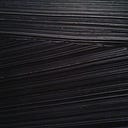Royal Ontario Museum, Toronto Celebrates Africa’s El Anatsui
Observations by ecodecoarora
Originally posted elsewhere on 9 February 2011
Deeply influenced by his birth continent, El Anatsui is probably Ghana’s best-known artist export. He resides and works in Nigeria and his is a methodical and calm manner that remakes and repurposes items into world-class art.
The breadth of detail and required imagination in folding, manipulating, shaping, and essentially mapping colourful gin, rum and wine bottle-tops into complex design patterns that create colour harmony and illuminate colour-led African stories is, to say the least, extraordinary. First seen hanging from afar, the bendable metal-weaved tapestries may appear as actual woven textiles, but upon closer inspection, re-seeing the art becomes a new experience. The viewer is drawn into the art because of its impressive scale and exquisite hand craftsmanship. In this beautiful show at the ROM, function meets wonderment in El Anatsui’s trademark tapestries! See what I mean, watch the trailer to Susan Vogel’s artist film: Fold Crumple Crush: The Art of El Anatsui.
Variety and flow, overall, are presented well by the show’s curators in this grouping that occupies the fourth floor of the ROM and brings together wood works, clay works, aluminium works, sculptures, and tapestries, which also consistently illustrate the Black African artist’s lingering themes of mobility, flexibility and dialogue. But the exhibition floor is an inherently challenging space in which to stage a show, despite its moveable walls, by virtue of its recreated design plan and implementation by renowned architect Daniel Libeskind. I can sympathetically imagine the issues that arise each time the curatorial team hand an exhibit in this space. As a consumer of art and borderless culture, and someone innately sensitive to space and light and movement, this was evidenced in the mise en scène of one El Anatsui installation that left me particularly affected.
Open(ing) Market (2004) is a vast sculptural display of thousands of tin boxes with three larger opened suitcases, wood-painted and tin-papered in colourful brands such as Milo, Emel and one strangely lined with the business card of the Victoria Miro Gallery! The work evokes communal living in an open marketplace, a co-existence that somehow works — quietly. However, as confining as this exhibition space is, in general, with regard to where the large sculpture had been installed, I feel neither the space nor the art was optimized to the best of their combined potential with the result that the piece, sadly, wasn’t speaking to me.
Firstly, it was obscured by shade in the room given that there were only ten track lights — not enough — affixed to the high, jagged ceiling which shone onto but notably away from El Anatsui’s work. Secondly, as I stood behind the crowd control barrier, I imagined a mirror reflection of equal jaggedness from atop the ceiling and facing down to mimic its strangely geometrical quarters hung onto the entire limited area so to reflect an aerial view of this bustling ‘market’. In so doing, the viewer would’ve felt just how dynamic such a marketplace actually can be in real life, particularly in this closed, triangular area of the ROM, while the unused space between ceiling and floor would’ve been spoken for. In my non-curatorial opinion, I believe it would’ve reflected so much better El Anatsui’s recurring themes of movement, flexibility and yes, dialogue! I was also bothered by the static resonance of the boxes, big and small: they were snubbing me (and themselves) by only profiling their one side; and I was hardly interacting with this ‘market’. I believe that sometimes the redundancy of a same object (for all intents and purposes) can create real dynamism and positive emotion which I had memorably experienced at other art shows.
Still in the same shared space, on the opposing wall hung Zebra Crossing III (2007) for which another version was donated to the AGO by Dr Murray Frum. Here again, space appears to have been at a premium — and also paying the mortgage to the detriment of easy viewer engagement.
Overall, however, I was pleased with my two-hour visit to the ROM on this Sunday afternoon. I appreciated Julie Crooks guided tour of El Anatsui’s work. Although, upsetting was how often her passionate delivery was disrupted by a toddler’s screeching while the parents were impervious to the frustration it caused our group as we struggled to engage with her commentary.
The El Anatsui exhibit closes on 27 February 2011 and travels to the Museum for African Art, in New York.
